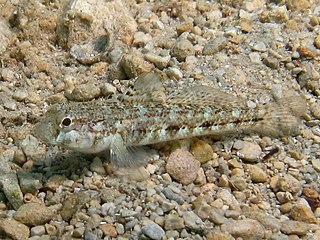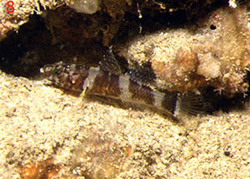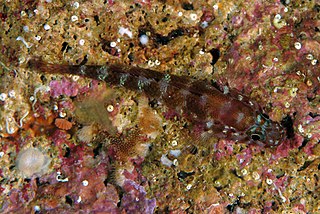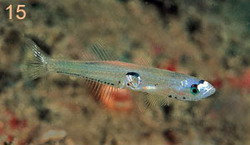
Padogobius bonelli, the Padanian goby, is a species of true goby from the family Gobiidae native to rivers of Croatia, Italy, Slovenia, and Switzerland, where it is usually found in areas with gravel substrates or along the edges of dense vegetation. Males of this species can reach a length of 8.6 centimetres (3.4 in) TL while females only reach 7.5 centimetres (3.0 in) TL. This species' specific name honours the Italian naturalist Franco Andrea Bonelli (1784-1830), who had originally described it as Gobius fluviatilis without realizing that this name was already being used for a different goby species, the monkey goby, which had been described by Pallas in 1814.
Wheelerigobius wirtzi, the Cameroon goby, is a species of goby native to the Atlantic coast of Africa where it is so far known from Victoria Bay, Cameroon and São Tomé Island. This fish has been found at a depth of about 1 metre (3.3 ft) on a vertical rock face. The species can reach a length of 3.5 centimetres (1.4 in) SL. The specific name honours the ichthyologist and blenny taxonomist Peter Wirtz who collected the type specimen.

Amblyeleotris wheeleri, the Gorgeous prawn-goby, is a species of goby native to tropical reefs of the Indian Ocean to the western Pacific Ocean. It can be found at depths of from 5 to 40 metres though is usually does not occur deeper than 15 metres (49 ft). It is a commensal with alpheid shrimps, most often being found in association with Alpheus ochrostriatus. This species can reach a length of 10 centimetres (3.9 in) SL. It can also be found in the aquarium trade.

Gobius kolombatovici is a species of goby native to the northern Adriatic Sea where it occurs at depths of from 15 to 38 metres in areas with patches of rock and softer sediments. This species can reach a length of 9.2 centimetres (3.6 in) SL. The specific name honours the Croatian mathematician, naturalist and taxonomist Juraj Kolombatovic (1843-1908), who carried out extensive work on the small inshore fishes of the Adriatic Sea.

Gobius roulei, Roule's goby, is a species of goby native to the eastern Atlantic Ocean and the Mediterranean Sea where it can be found at depths of from 320 to 385 metres. This species can reach a length of 8 centimetres (3.1 in) TL. The specific name honours the French zoologist Louis Roule (1861-1942) who was the collector of the type.

Couch's goby is a species of goby native to the northeastern Atlantic Ocean as far north as southern Great Britain and Ireland, the Mediterranean Sea and the Adriatic Sea where it can be found living under stones on muddy sand in inshore waters and in the intertidal zone. This species can reach a length of 7.7 centimetres (3.0 in) TL. The specific name and common name both honour Jonathan Couch (1789–1870), the Cornish ichthyologist and the author of A History of the Fishes of the British Islands published between 1862 and 1867.
Gobius scorteccii is a species of freshwater goby native to Somalia, Africa. This species can reach a length of 13.6 centimetres (5.4 in) TL. The specific name honours the Italian herpetologist Giuseppe Scortecci (1898-1973) of the University of Genoa, who was the collector of the type.
Gobius senegambiensis is a species of marine fish from the family Gobiidae, the true gobies. It is native to the Atlantic Ocean from Morocco to Angola as well as the islands in the Gulf of Guinea. It is found in inshore waters on sandy bottoms. This species can reach a length of 7.3 centimetres (2.9 in) SL.

Pomatoschistus knerii, Kner's goby, is a species of goby native to the western basin of the Mediterranean Sea and the Adriatic Sea. This species occurs in areas with soft substrates near to rocks or beds of seagrass. The specific name most likely honours the Austrian ichthyologist Rudolf Kner (1810-1869), who was a friend of the author Franz Steindachner.

Didogobius is a genus of small marine fish in the family Gobiidae, the true gobies. They are native to the eastern Atlantic Ocean and the Mediterranean Sea. The name of the genus is a compound noun made up of Dido, the mythical founder and first queen of Carthage, and the Latin gobius meaning "goby".
Ben-Tuvia's goby is a species of goby native to the Mediterranean Sea along the coast of Israel where it can be found on muddy sand bottoms at around a depth of 37 metres (121 ft). Both the specific name and the common name honour the Israeli ichthyologist Adam Ben-Tuvia (1919-1999) of the Hebrew University of Jerusalem, who collected type and who has made a significant contribution to the knowledge of the Mediterranean fish fauna.

Didogobius splechtnai is a species of goby native to the Mediterranean Sea along the coasts of Spain and Italy where they inhabit caves with sandy substrates at depths from 7 to 11 m. This species can reach a standard length of 2.3 cm (0.91 in). The specific name honours Professor Heinz Splechtna (1933-1996), a marine biologist at the University of Vienna.

Steinitz's goby is a species of goby. It is native to the Mediterranean Sea near Marseilles. It has been recently recorded in the Adriatic Sea in Croatia, Tyrrhenian Sea in Italy, and in the Black Sea in Ukraine. This species can be found in underwater grottoes in inshore waters at depths of 2 to 15 metres. Steinitz's goby can reach a length of 3.8 centimetres (1.5 in) SL. Its name honours the marine biologist and herpetologist Heinz Steinitz (1909–1971) of the Hebrew University, Jerusalem.

Crystallogobius linearis, the crystal goby, is a species of goby native to the Atlantic coasts of Europe and the Mediterranean Sea where it can be found at depths of from 1 to 400 metres. Males of this species grow to a length of 4.7 centimetres (1.9 in) SL while females only reach 3.9 centimetres (1.5 in) SL. This species is the only known member of its genus. The name Crystallogobius comes from the Latin words cristallum, meaning "crystal", and gobius, meaning gudgeon.
Ebomegobius goodi is a species of brackish water goby native to a stream in Cameroon and is known from a single specimen. This species grows to a length of 3.5 centimetres (1.4 in) SL. This species is the only known member of its genus. The genus name is a compound of Ebomé, the brackish stream where the species was found, and gobius while the specific name honours the missionary Albert Irwin Good (1884-1975), who collected West African fishes and collected the type of this species.

Sicydium plumieri is a freshwater species of the goby native to the Antilles from Cuba to Trinidad and Tobago, though not recorded from all islands. This species can reach a length of 11 centimetres (4.3 in) TL. It is also known by the English common names sirajo, Plumier's stone-biting goby, and tri-tri goby. The young, which are regarded as a delicacy, are of commercial importance. The specific name honours Charles Plumier (1646-1704), a Franciscan friar and naturalist, who found the first specimens of the species on Martinique and Marcus Elieser Bloch based his species description on Plumier's drawings.
Hyrcanogobius bergi, the Volga dwarf goby, is a species of goby endemic to the Caspian Sea where it occurs in fresh, brackish and marine waters along the coast. Unusual for gobies, this species is almost a fully pelagic fish. H. bergi grows to a length of 3.6 centimetres (1.4 in) SL. This species is also the only known member of its genus. The specific name honours the Soviet zoologist Lev Berg (1876-1950) who described many new species of goby from the Caspian Sea.

Chaenogobius annularis, the fork-tongued goby, is a species of goby from the subfamily Gobionellinae which is found in the brackish waters of temperate eastern Asia. It is the type species of the genus Chaenogobius.
Ophiogobius jenynsi is a species of ray-finned fish from the biology Gobiidae, the true gobies. It is a demersal, marine species which is found off the coast of Chile in the intertidal zone. It feeds mainly on crustaceans. This species was originally named as Gobius ophicephalus by Leonard Jenyns in 1842, subsequently misspelt as ophiocephalus, but this name was preoccupied by Pallas's 1811 Gobius ophiocephalus, Hoese renamed the species in honour of Jenyns in 1976. This is the only species in its genus.
Awaous commersoni, or Commerson's freshwater goby, is a species of goby found on islands in the south-western Indian Ocean.













